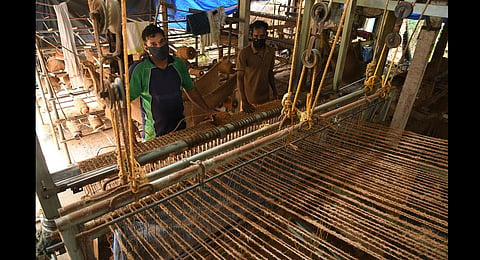

Alappuzha district has witnessed several labour uprisings that left a lasting imprint on the history of people’s movement in Kerala. Coir workers, farm labourers and fishers constitute the majority of the population, and it is their sentiments that determine the district’s socio-political stature. However, the district is grappling with the economic fallout of the migration of coir industry to TN
It is known the world over as the Venice of the East. A land where nature has showered her blessings generously. The lush green paddy fields of Kuttanad — called the rice bowl of Kerala — located below sea level, the idyllic backwaters, toddy shops on the banks of the tranquil lagoons that serve lip-smacking duck curry and fish delicacies, the canals crisscrossing the town, the luxurious houseboats and the long coastline make Alappuzha a tourists’ paradise.
Alappuzha has a rich heritage of trade relations with ancient Greece and Rome. The Punnapra-Vayalar uprising against Diwan C P Ramaswamy Aiyar — a memorable episode of the working class revolt against oppression — bears a testimony to the district’s illustrious past.In the 1940s, when Travancore was under the grip of famine the farmers of Kuttanad showed the way by reclaiming long stretches of the backwaters by constructing bunds. It is the land of men who beat destiny with sheer willpower.
Around 45 per cent of the residents of the district are Ezhavas and the politically sensitive community has an affinity towards communists. Though SNDP Yogam vice-president Thushar Vellappally formed Bharat Dharma Jana Sena and aligned with the BJP, the communists still enjoy the support of the working class. Coir workers, farm labourers and fishermen constitute a majority of voters and it is their sentiments that holds sway in the elections.
The eyes of 81-year-old Kesavan, a veteran communist, gleamed with pride as memories came rushing about the turbulent days of Punnapra Vayalar struggle in the October of 1946. “I was around six when the uprising took place. I still remember the days when farm workers prepared the ‘varikuntham’ (spears) in our courtyard. They fought the gun-wielding British and Travancore police with these wooden spears. More than 600 people were killed in the uprising. All the men in the village went hiding as the police raided the houses and I spent the night in fear holding on to my mother as police knocked at our doors,” he said.
Coir industry migrates to TN
Kerala spread its name far and wide with the fabled golden fibre that is interwoven with the lives of the four lakh coir workers in Alappuzha district. However, the traditional industry has slipped into decline.
With the steep decline in availability of quality coconut husk, the sector has been wholly dependent on the coir units in Tamil Nadu’s Pollachi for sustenance. Increasing labour issues and high wages have forced the coir industry to migrate to Tamil Nadu. According to industry leaders, the diversification to coir geotextiles has led to a steep drop in the availability of quality fibre. However, workers have a different story to tell.
“There is good demand for coir geotextiles, which is used to stop soil erosion. We shifted to making geotextiles fibre as we get better wages. Two workers can operate the spinning machine in which we weave geotextiles mat, which is 2 metres wide and 50 metres long. We get Rs 950 for a 50-metre-long mat and we can make three mats a day,” said Udayan, a worker at 'Lal Coir Works' in Kanjikuzhy.
“Around 40 per cent of the units that manufacture export-quality coir mats have migrated to Tamil Nadu. We are not getting quality fibre in Kerala. While the wages have gone up to Rs 1,150 in Kerala the average wage is Rs 400 in Tamil Nadu. The transportation cost and the high wages force us to raise the price of the product. We are unable to compete with Tamil Nadu units in price,” said Vivek Venugopal, a coir exporter.
The Centre’s decision to withdraw the Merchandise Exports from India Scheme that offers 5 per cent reward to the exporters to offset infrastructural inefficiencies and associated costs, has landed the industry in deep trouble, he said. “The competition is tough and the profit has nose-dived, said Vivek.
However, there is some positive news that has boosted the confidence of entrepreneurs.
“While exports plunged in most of the sectors during the lockdown period, the coir sector experienced a positive turn as there was a new-found enthusiasm in Western market. There was a 20 per cent increase in the export of coir to Europe and America. As people stayed put in their houses during the lockdown period and many started working from home, they started furnishing their houses. There is an increase in demand for home decor products and the coir sector has benefitted from this,” Vivek said.